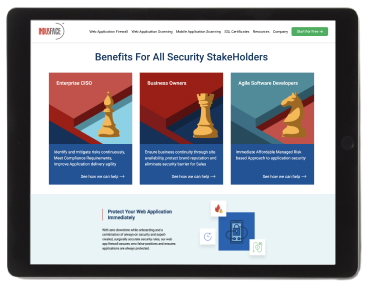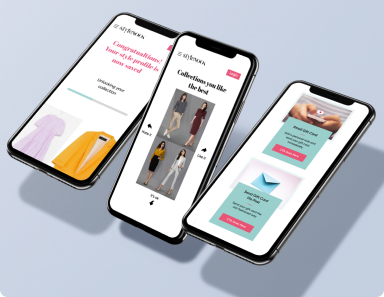Brands that trust us
A design thinking process essentially comprises six steps
Empathize
Understanding the needs and behaviors of your audience and how the problem or solution will affect them. This stage involves conducting interviews and engaging with stakeholders to gain insights into their experiences.
Define
Analyzing the problem basis the insights gained in order to arrive at the problem statement, which guides the way to ideation and developing a solution.
Ideate
A brainstorming process where creativity and open-mindedness are at the forefront in order to delve into all perspectives. This stage could also include mind mapping and sketching.
Prototype
Creating variations of potential solutions that can be tested and developed upon. Prototyping can involve sketching, creating physical models or digital simulations, or even role playing scenarios.
Test
Testing the prototypes to understand what works and what doesn’t. The goal is to evaluate how well the proposed solution meets expectations/needs of intended users.
Iterate
Segueing from the Test phase, designers develop the prototype that comes the closest to the intended users’ expectations through refinements. The iterative stage continues until a desirable and viable solution is developed.
Throughout the design thinking process, collaboration, experimentation, and a willingness to embrace ambiguity and failure are key to learning and growth.
What is Design Thinking?

Definition
Design thinking is a problem-solving methodology that emphasizes empathy for users, creativity in generating ideas, and iterative prototyping and testing to develop innovative solutions.
Concept
The basic concept of design thinking revolves around approaching problem-solving from a human-centered perspective.
It involves understanding the needs, desires, and behaviors of the people affected by the problem, generating creative solutions, and iteratively testing and refining those solutions based on feedback.
Design thinking encourages collaboration, empathy, experimentation, and a willingness to embrace ambiguity in order to arrive at innovative and effective solutions.
Key Principles
The key principles of design thinking include
Empathy
Iterative
Creativity
Action-oriented
A human-centric approach
Collaboration
Prototype-driven
By embracing these principles, design thinking enables teams to tackle complex problems, drive innovation, and create solutions that meet the needs and desires of users.
Benefits and Importance
Design thinking empowers organizations to tackle challenges in a human-centered, creative, and collaborative fashion, leading to highly innovative and effective solutions.
Benefits of Design Thinking:
User-Centric Solutions
Design thinking places users at the center of the problem-solving process, resulting in solutions that better meet their needs and preferences.
Innovation and Creativity
By encouraging divergent thinking and exploration of multiple ideas, design thinking fosters innovation and creativity, leading to novel solutions to complex problems.
Collaboration
Design thinking promotes interdisciplinary collaboration, allowing diverse teams to work together to generate and refine ideas. This collaborative approach harnesses the collective intelligence and expertise of team members.
Iterative Improvement
The iterative nature of design thinking enables rapid prototyping and testing of solutions, facilitating continuous improvement based on user feedback and insights gathered throughout the process.
Risk Mitigation
By validating ideas through prototyping and testing early in the process, design thinking helps mitigate the risk of investing time and resources into solutions that may not meet user needs or solve the problem effectively.
Empathy and Understanding
Design thinking encourages practitioners to develop a deep understanding of users' needs, motivations, and experiences, fostering empathy and enabling more meaningful and impactful solutions.
Adaptability
Design thinking is a flexible and adaptable approach that can be applied to a wide range of challenges and contexts, making it suitable for addressing both simple and complex problems across various industries and disciplines.
“I believe in the power of design thinking to transform customer experiences. It's not just about innovation; it's about empathy, authenticity, and genuine connections. By understanding and addressing the real challenges our customers face, Let’s create solutions that resonate deeply and drive meaningful impact.”
- Vaishnavi Reddy
CEO, OriginUX


Our Approach to Design Thinking Workshops
Design Thinking Methodology
Encouraging organizations to adopt a design-centric ethos that prioritizes customers fosters a unique competitive edge.
By embracing the principles of design thinking, businesses can unearth unmet customer needs and anticipate future opportunities. This strategic approach enables companies to develop holistic offerings tailored to delight customers, while also fortifying their position against market competitors and generating novel value propositions.

Interact
with business stakeholders, technologists, marketers, product and service evangelists, and introduce new possibilities and potential initiatives and solutions to existing roadblocks.
Collaborate
with expert facilitators to apply agile concepts in workshops. Topics include rapid prototyping, customer journeys and business KPIs while also touching on technology possibilities or marketing narratives.
Understand
your customers’ and users’ points of view and behavior. Develop conversations with key innovators, and get exposure to their perspective and foster fresh ways of thinking.
Design
and scale new digital experiences through collaborative workshops, envision how they could be integrated into your business. Essentially, we leverage our expertise, ideas and findings to reimagine user experiences.
My process to conduct Design Thinking workshops
Design thinking is a powerful tool for businesses large and small. It can have an impact on customer satisfaction, revenue growth rates as well cost-to-serve departments while also positively impacting employee engagement levels in the process.
Design thinking helps us understand our customers and users at every step in their decision journey. It also creates a map for meeting an organization’s underlying requirements by empathizing with them, exploring possibilities through:
Definition
What do your customers care about? And how can you identify their needs to make sure they get the most out of their experience with you.
Research
Apply research and psychology. And that means digital technologies as well to create new, memorable experiences.
Experiment
Prototyping is the backbone of any successful product. Test your ideas with end users and get feedback for a sense for how your idea will feel in reality.
Design and Scale
Create outcomes for all stakeholders of your organization. Design thinking helps with achieving company goals towards shared ambitions.
Solutions Offered
Overview
Take the path of design excellence with OriginUX Studio, as our teams of analysts, researchers, designers and developers work alongside your team’s capabilities and business values to better understand your offerings, uncover customer and user insights, craft exceptional customer experiences, and successfully envision them through product, service and customer experience design.
Solutions
Product Design
We specialize in imagining customer experiences for SaaS Products.
We start by learning where you are and where you want to get to. Based on the lifecycle and maturity of the product or idea, we start by exploring your requirements and unmet needs of your consumer.
Through design thinking workshops, scope discovery and rapid prototyping, our design teams align all stakeholders, commercial use cases, customer experiences and even devops and to fully support your product launch.
Service Design
We craft service design and strategy and take accountability to meet business outcomes.
Through improvised design experience, we will help you drive strategic priorities within your organizations. Companies today seek design intervention at all stages of interaction to empower people at all levels.
By empathizing with employees and customers at every step in their journey, we re-imagine an experience that meets their needs and delivers a unified business outcome. Through design practices, our UX modernizations move the needle of impact from customer satisfaction to revenue growth to operational excellence and employee engagement.
Customer Experience Design
Infuse your organization with a Customer-Delight culture that puts the users at the core and provides your brand with real, measurable results along with a competitive advantage.
Good design is good business. Gone are the days of siloed design and experiences. Customer experiences are now connected more than ever and are more integrated with business strategy, marketing strategy, marketing execution, operations, and product design.
Reinvent your business from the core. We bring experience strategy, data and analytics, interaction design, and implementation expertise for you to ace customer delight.













































